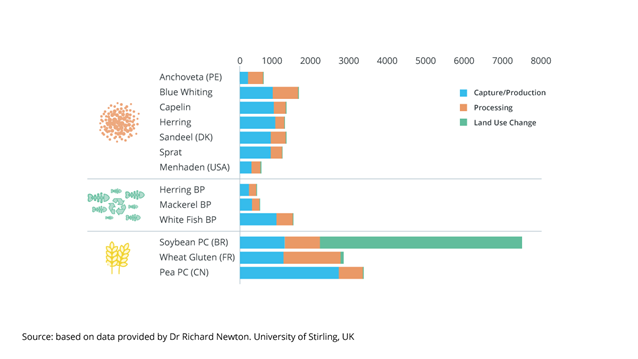This piece was written by Dr Brett Glencross and published in the January 2022 edition of International Aquafeed
In the city of Glasgow, not far from where I live in my adopted home country of Scotland, many of the world’s leaders convened at the 26th United Nations Climate Change conference (COP26) in November 2021. Most of the focus was on the required collective efforts to address future climate change challenges. A range of outcomes were achieved, including agreements on lowering emissions, phasing out the use of coal and improved forest conservation. However, something that to me at least was conspicuous by its absence, was clear progress on food production systems. We all know the science the on how we have arrived at this point – centuries of carbon pollution, mostly in the form of carbon dioxide, and methane among others, that we now collectively refer to as greenhouse gases (GHG). While there are many different origins of thee GHG, it is notably the emissions from the global food production system that is one of the main drivers. Therefore, clearly a reduction in global food consumption through reducing our calorie and protein intake and/or population reduction is one strategy, but not a politically attractive one. The main strategy appears to focus on reducing GHG emissions through a reduction in fossil fuel use and/or the capture of those emissions to try and achieve a net zero balance. Maybe the other “balance” we should be thinking about is how much we rely on food production from terrestrial versus marine systems.
It seems that most of thinking in terms of improving food production footprint is based in terrestrial agriculture of livestock and crops, GREEN food production systems. But what about food production from marine capture and farming, what about BLUE food? A recent study by MacLeod et al., (2020) has shown that marine food production via aquaculture is in a very good position to assist with the reduction of GHG emissions. The authors showed that aquaculture is typically a lower emitter compared to virtually all other animal production systems. The authors demonstrated that increasingly moving our animal protein production systems off land and into the sea to create a “blue food sector”, where we move our reliance away from terrestrial ecosystems to create a better balance in ecosystem reliance by producing more food from the sea, will be one strategy to address our reduction of GHG emissions. Indeed, in Naylor et al’s (2021) recent 20-year retrospective of global aquaculture they highlighted the role that culture of molluscs and seaweed can have in terms of net carbon removal from the system. Imagine that a food production system that actually has restorative impacts on GHG emissions. That could be one of the benefits of a blue food revolution.
Improving efficiencies of resource use is another central theme in this sustainability story. In terms of animal production, again aquaculture reigns supreme in this regard. The lack of a need to burn energy for body temperature regulation, combined with other features like being able to completely metabolise protein to ammonia, make fish among the most efficient of all animals to farm. The other emerging element to that story is the use of “circular” ingredients in animal production. Responding to this demand there has been a boom in new enterprises promoting insects, single-cell proteins, and microalgae, among others but notably the only circular ingredients with any scale are the use of fishmeal and oil from trimmings and by-products. In 2020 this sector of the marine ingredients industry produced close to two million tonnes, clearly putting it in a different league to the newer emerging “novel” ingredients sector. In fact, if we combine the low carbon aspect of marine ingredient production with the “circular” protein strategy we take something that has a pretty good environmental footprint; low CO2 discharge, low energy use, and little to no reliance land or freshwater, and make it into something super special, an ingredient with superb nutritional properties and an even lower carbon footprint (Figure 1). By comparison, when we examine the various alternative proteins and oils now being used and/or considered and we find that they typically have a high demand for energy, a higher CO2 footprint and use substantially more land and freshwater. So even though they contribute desperately needed new nutrients into our feed-chain, this is not without some environmental cost.
Maybe something we need to further consider here is the carbon cost of an ingredient as an additional use criterion in feed formulation, and I note that several feed manufacturers are now publicly reporting their abilities to do as such. Notably, such a move would transfer additional cost to the higher carbon footprint ingredients, while at the same time encouraging the use of those ingredients with a low carbon footprint and at the same time monetising that point-of-difference to further encourage production of the low carbon footprint ingredients. Irrespective of the strategy we adopt to reducing GHG emissions, this whole issue of sustainability and carbon footprint is going to become increasingly highlighted and sooner or later the carbon-cost will become part of the cost we all pay.

Figure 1. Carbon footprint of different raw materials widely used by the aquafeed industry.
MacLeod, M. J., Hasan, M. R., Robb, D. H., & Mamun-Ur-Rashid, M. (2020). Quantifying greenhouse gas emissions from global aquaculture. Scientific Reports, 10(1), 1-8.
Naylor, R. L., Hardy, R. W., Buschmann, A. H., Bush, S. R., Cao, L., Klinger, D. H., ... & Troell, M. (2021). A 20-year retrospective review of global aquaculture. Nature, 591(7851), 551-563.








